Spatial and Temporal Variation Characteristics of Air Pollutants in Coastal Areas of China: From Satellite Perspective
Abstract
1. Introduction
2. Materials and Methods
2.1. Study Area
2.2. Data Sources and Pre-Processing
2.2.1. Sentinel-5P Data
- (1)
- Dataset and band selection: The data used in this study are openly available via the Google Earth Engine platform (dataset: ‘SO2’: ‘COPERNICUS/S5P/OFFL/L3_SO2’, ‘NO2’: ‘COPERNICUS/S5P/OFFL/L3_NO2’, ‘HCHO’: ‘COPERNICUS/S5P/OFFL/L3_ HCHO’, ‘O3’: ‘COPERNICUS/S5P/OFFL/L3_O3’, ‘CO’: ‘COPERNICUS/S5P/OFFL/L3_CO’, ‘CH4’: ‘COPERNICUS/S5P/OFFL/L3_CH4’). Data from 1 January 2019 to 31 December 2024 were selected for this study, and pixels with QA values less than 30 were filtered to ensure the quality of the data images. A total of 183,051 images were processed, amounting to approximately 700 GB of data.
- (2)
- Image pre-processing and cloud filtering: In order to improve the quality of the images, cloud filtering was applied to the images. If the image contained “cloud_fraction” or “cloud_height” bands, then less than 30% cloud amount or 10,000 m cloud height was applied as the filtering condition, respectively; if there was no cloud information, then the processing was skipped. In addition, the images were regionally clipped and unmasked to compensate for missing pixels.
- (3)
- Image synthesis of monthly and annual averages: Monthly and annual spatial distribution datasets for each pollutant were generated using the mean synthesis method for further analysis.
2.2.2. Ship Density Data
2.2.3. Port Boundary Data
2.3. Methodology
2.3.1. Trend Analysis Methods
2.3.2. Correlation Analysis
3. Results
3.1. Temporal Variation Characteristics of Six Air Pollutants in China’s Coastal Regions
3.2. Spatial Distribution Patterns and Changing Characteristics of Six Air Pollutants in China’s Coastal Areas
3.3. Results of Trend Analyses for Six Air Pollutants
4. Discussion
4.1. Relationship Between Ship Density and Pollutant Concentrations
4.2. Characteristics of Pollutant Distribution in Major Ports
4.3. Strengths, Limitations of Satellite-Based Analysis
5. Conclusions
- (1)
- The concentrations of SO2, HCHO, and CH4 show a continuous increasing trend, while NO2, CO, and O3 remained relatively stable or showed slight decreases. All six pollutants demonstrated pronounced seasonal variations: NO2 peaked in spring and autumn, O3 concentrations were highest in summer, and CH4 increased rapidly in spring and summer.
- (2)
- Pollutant concentrations were higher along the northern coast (Yellow Sea and Bohai Sea) and relatively lower in the South China Sea region. NO2, SO2, and O3 levels were elevated in the Bohai area, while high concentrations of HCHO and CO were primarily observed along the northern coast. CH4 concentrations were higher in the north and in certain ports within the Yangtze River Delta.
- (3)
- Ship density showed a significant positive correlation with NO2, SO2, HCHO, CO, and CH4, indicating that ship emissions are an important source of these pollutants. Although O3 is not directly emitted by ships, it still showed a positive correlation in some high-density shipping areas, suggesting its formation is influenced by photochemical reactions involving NO2 and VOCs.
- (4)
- Higher concentrations of NO2, SO2, HCHO, CO, and CH4 were found in northern ports such as Tianjin Xingang, Qinhuangdao, Tangshan, and Dalian, whereas pollution levels were relatively low in southern ports including Shenzhen, Xiamen, and Haikou.
Author Contributions
Funding
Data Availability Statement
Acknowledgments
Conflicts of Interest
References
- Christodoulou, A.; Gonzalez-Aregall, M.; Lindé, T.; Vierth, I.; Cullinane, K. Targeting the reduction of shipping emissions to air. Marit. Bus. Rev. 2019, 4, 16–30. [Google Scholar] [CrossRef]
- Kontovas, C. Integration of air quality and climate change policies in shipping: The case of sulphur emissions regulation. Mar. Policy 2020, 113, 103815. [Google Scholar] [CrossRef]
- Wang, H.; Lyu, X.; Guo, H.; Wang, Y.; Zou, S.; Ling, Z.; Wang, X.; Jiang, F.; Zeren, Y.; Pan, W.; et al. Ozone pollution around a coastal region of South China Sea: Interaction between marine and continental air. Atmos. Chem. Phys. 2018, 18, 4277–4295. [Google Scholar] [CrossRef]
- Fan, L.; Xu, Y.; Luo, M.; Yin, J. Modeling the interactions among green shipping policies. Marit. Policy Manag. 2021, 49, 62–77. [Google Scholar] [CrossRef]
- Prud’homme, G.; Dobbin, N.A.; Sun, L.; Burnett, R.T.; Martin, R.V.; Davidson, A.; Cakmak, S.; Villeneuve, P.J.; Lamsal, L.N.; van Donkelaar, A.; et al. Comparison of remote sensing and fixed-site monitoring approaches for examining air pollution and health in a national study population. Atmos. Environ. 2013, 80, 161–171. [Google Scholar] [CrossRef]
- Stratoulias, D.; Nuthammachot, N.; Dejchanchaiwong, R.; Tekasakul, P.; Carmichael, G. Recent Developments in Satellite Remote Sensing for Air Pollution Surveillance in Support of Sustainable Development Goals. Remote Sens. 2024, 16, 2932. [Google Scholar] [CrossRef]
- Veefkind, J.P.; Aben, I.; McMullan, K.; Förster, H.; De Vries, J.; Otter, G.; Claas, J.; Eskes, H.; De Haan, J.; Kleipool, Q. TROPOMI on the ESA Sentinel-5 Precursor: A GMES mission for global observations of the atmospheric composition for climate, air quality and ozone layer applications. Remote Sens. Environ. 2012, 120, 70–83. [Google Scholar] [CrossRef]
- Latsch, M.; Richter, A.; Eskes, H.; Sneep, M.; Wang, P.; Veefkind, P.; Lutz, R.; Loyola, D.; Argyrouli, A.; Valks, P.; et al. Intercomparison of Sentinel-5P TROPOMI cloud products for tropospheric trace gas retrievals. Atmos. Meas. Tech. 2022, 15, 6257–6283. [Google Scholar] [CrossRef]
- Lakkala, K.; Kujanpää, J.; Brogniez, C.; Henriot, N.; Arola, A.; Aun, M.; Auriol, F.; Bais, A.F.; Bernhard, G.; De Bock, V.; et al. Validation of the TROPOspheric Monitoring Instrument (TROPOMI) surface UV radiation product. Atmos. Meas. Tech. 2020, 13, 6999–7024. [Google Scholar] [CrossRef]
- Harbi, M.; Rasheed, H.A.; Abed, H.; Mohsein, O. The Role of Remote Sensing in Assessing and Mitigating Environmental Pollution: A Narrative Review. Eur. J. Theor. Appl. Sci. 2024, 2, 268–278. [Google Scholar] [CrossRef]
- Savenets, M.; Oreshchenko, A.; Nadtochii, L. The system for near-real time air pollution monitoring over cities based on the Sentinel-5P satellite data. Geol. Geogr. Ecol. 2022, 57, 195–205. [Google Scholar] [CrossRef]
- Georgoulias, A.K.; Boersma, K.F.; van Vliet, J.; Zhang, X.; van der A, R.; Zanis, P.; de Laat, J. Detection of NO2 pollution plumes from individual ships with the TROPOMI/S5P satellite sensor. Environ. Res. Lett. 2020, 15, 124037. [Google Scholar] [CrossRef]
- Souri, A.H.; Chance, K.; Bak, J.; Nowlan, C.R.; González Abad, G.; Jung, Y.; Wong, D.C.; Mao, J.; Liu, X. Unraveling pathways of elevated ozone induced by the 2020 lockdown in Europe by an observationally constrained regional model using TROPOMI. Atmos. Chem. Phys. 2021, 21, 18227–18245. [Google Scholar] [CrossRef]
- Sheng, H.; Fan, L.; Chen, M.; Wang, H.; Huang, H.; Ye, D. Identification of NOx emissions and source characteristics by TROPOMI observations—A case study in north-central Henan, China. Sci. Total Environ. 2024, 931, 172779. [Google Scholar] [CrossRef]
- Wang, C.; Wang, T.; Wang, P.; Wang, W. Assessment of the Performance of TROPOMI NO2 and SO2 Data Products in the North China Plain: Comparison, Correction and Application. Remote Sens. 2022, 14, 214. [Google Scholar] [CrossRef]
- Galli, A.; Butz, A.; Scheepmaker, R.A.; Hasekamp, O.; Landgraf, J.; Tol, P.; Wunch, D.; Deutscher, N.M.; Toon, G.C.; Wennberg, P.O.; et al. CH4, CO, and H2O spectroscopy for the Sentinel-5 Precursor mission: An assessment with the Total Carbon Column Observing Network measurements. Atmos. Meas. Tech. 2012, 5, 1387–1398. [Google Scholar] [CrossRef]
- Tamiminia, H.; Salehi, B.; Mahdianpari, M.; Quackenbush, L.; Adeli, S.; Brisco, B. Google Earth Engine for geo-big data applications: A meta-analysis and systematic review. ISPRS J. Photogramm. Remote Sens. 2020, 164, 152–170. [Google Scholar] [CrossRef]
- Verschuur, J.; Koks, E.E.; Li, S.; Hall, J.W. Multi-hazard risk to global port infrastructure and resulting trade and logistics losses. Commun. Earth Environ. 2023, 4, 5. [Google Scholar] [CrossRef]
- Gocic, M.; Trajkovic, S. Analysis of changes in meteorological variables using Mann-Kendall and Sen’s slope estimator statistical tests in Serbia. Glob. Planet. Change 2013, 100, 172–182. [Google Scholar] [CrossRef]
- Feng, X.; Ma, Y.; Lin, H.; Fu, T.-M.; Zhang, Y.; Wang, X.; Zhang, A.; Yuan, Y.; Han, Z.; Mao, J.; et al. Impacts of Ship Emissions on Air Quality in Southern China: Opportunistic Insights from the Abrupt Emission Changes in Early 2020. Environ. Sci. Technol. 2023, 57, 16999–17010. [Google Scholar] [CrossRef]
- Zhao, J.; Zhang, Y.; Patton, A.P.; Ma, W.; Kan, H.; Wu, L.; Fung, F.; Wang, S.; Ding, D.; Walker, K. Projection of ship emissions and their impact on air quality in 2030 in Yangtze River delta, China. Environ. Pollut. 2020, 263, 114643. [Google Scholar] [CrossRef] [PubMed]
- Wang, X.; Yi, W.; Lv, Z.; Deng, F.; Zheng, S.; Xu, H.; Zhao, J.; Liu, H.; He, K. Ship emissions around China under gradually promoted control policies from 2016 to 2019. Atmos. Chem. Phys. 2021, 21, 13835–13853. [Google Scholar] [CrossRef]
- Lindstad, E.; Rialland, A. LNG and Cruise Ships, an Easy Way to Fulfil Regulations—Versus the Need for Reducing GHG Emissions. Sustainability 2020, 12, 2080. [Google Scholar] [CrossRef]
- Wang, R.; Tie, X.; Li, G.; Zhao, S.; Long, X.; Johansson, L.; An, Z. Effect of ship emissions on O3 in the Yangtze River Delta region of China: Analysis of WRF-Chem modeling. Sci. Total Environ. 2019, 683, 360–370. [Google Scholar] [CrossRef]
- Wang, X.; Shen, Y.; Lin, Y.; Pan, J.; Zhang, Y.; Louie, P.K.K.; Li, M.; Fu, Q. Atmospheric pollution from ships and its impact on local air quality at a port site in Shanghai. Atmos. Chem. Phys. 2019, 19, 6315–6330. [Google Scholar] [CrossRef]
- Guo, X.; Zhang, Z.; Cai, Z.; Wang, L.; Gu, Z.; Xu, Y.; Zhao, J. Analysis of the Spatial–Temporal Distribution Characteristics of NO2 and Their Influencing Factors in the Yangtze River Delta Based on Sentinel-5P Satellite Data. Atmosphere 2022, 13, 1923. [Google Scholar] [CrossRef]
- Li, X.-Z.; Peng, Z.-R.; Fu, Q.; Wang, Q.; Pan, J.; He, H. A Data-Driven Approach to Identify Major Air Pollutants in Shanghai Port Area and Their Contributing Factors. J. Mar. Sci. Eng. 2024, 12, 288. [Google Scholar] [CrossRef]
- Yuan, Q.; Teng, X.; Tu, S.; Feng, B.; Wu, Z.; Xiao, H.; Cai, Q.; Zhang, Y.; Lin, Q.; Liu, Z.; et al. Atmospheric fine particles in a typical coastal port of Yangtze River Delta. J. Environ. Sci. 2020, 98, 62–70. [Google Scholar] [CrossRef]
- Chen, F.; Wang, L.; Wang, Y.; Zhang, H.; Wang, N.; Ma, P.; Yu, B. Retrieval of dominant methane (CH4) emission sources, the first high-resolution (1–2 m) dataset of storage tanks of China in 2000–2021. Earth Syst. Sci. Data 2024, 16, 3369–3382. [Google Scholar] [CrossRef]
- Zang, K.; Zhang, G.; Wang, J. Methane emissions from oil and gas platforms in the Bohai Sea, China. Environ. Pollut. 2020, 263, 114486. [Google Scholar] [CrossRef]
- Li, Z.; Jun Feng, C.; Jun Ya, D. Air Pollution and Control of Cargo Handling Equipments in Ports. E3S Web Conf. 2019, 93, 02001. [Google Scholar] [CrossRef]
- Zhang, J.; Zhang, S.; Wang, Y.; Bao, S.; Yang, D.; Xu, H.; Wu, R.; Wang, R.; Yan, M.; Wu, Y.; et al. Air quality improvement via modal shift: Assessment of rail-water-port integrated system planning in Shenzhen, China. Sci. Total Environ. 2021, 791, 148158. [Google Scholar] [CrossRef] [PubMed]
- Yang, Y.; Zhang, Y.; Fu, S. Prediction and Mitigation of PM2.5 in Coastal Ports of China. In Proceedings of the 7th International Conference on Transportation Information and Safety (ICTIS 2023), Xi’an, China, 4–9 August 2023; pp. 275–281. [Google Scholar] [CrossRef]
- Tian, X.; Xie, P.; Xu, J.; Li, A.; Wang, Y.; Qin, M.; Hu, Z. Long-term observations of tropospheric NO2, SO2 and HCHO by MAX-DOAS in Yangtze River Delta area, China. J. Environ. Sci. 2018, 71, 207–221. [Google Scholar] [CrossRef]
- Holloway, T.; Miller, D.; Anenberg, S.; Diao, M.; Duncan, B.; Fiore, A.; Henze, D.; Hess, J.; Kinney, P.; Liu, Y.; et al. Satellite Monitoring for Air Quality and Health. Annu. Rev. Biomed. Data Sci. 2021, 4, 417–447. [Google Scholar] [CrossRef]
- Dey, S.; Chowdhury, S. Air quality management in India using satellite data. In Asian Atmospheric Pollution; Elsevier: Amsterdam, The Netherlands, 2022. [Google Scholar] [CrossRef]
- O’Dell, K.; Kondragunta, S.; Zhang, H.; Goldberg, D.; Kerr, G.; Wei, Z.; Henderson, B.; Anenberg, S. Public Health Benefits From Improved Identification of Severe Air Pollution Events With Geostationary Satellite Data. GeoHealth 2024, 8, e2023GH000890. [Google Scholar] [CrossRef]
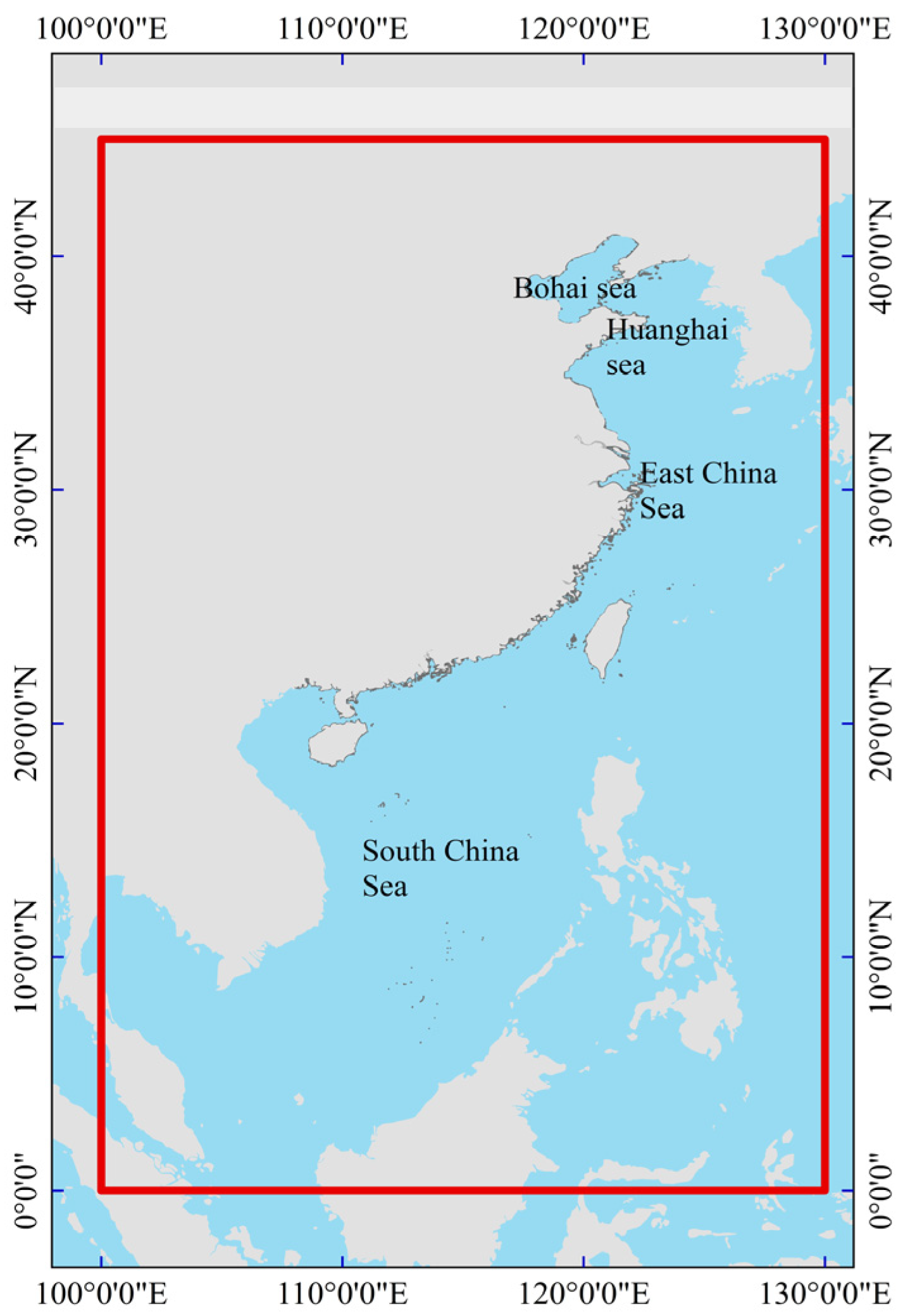
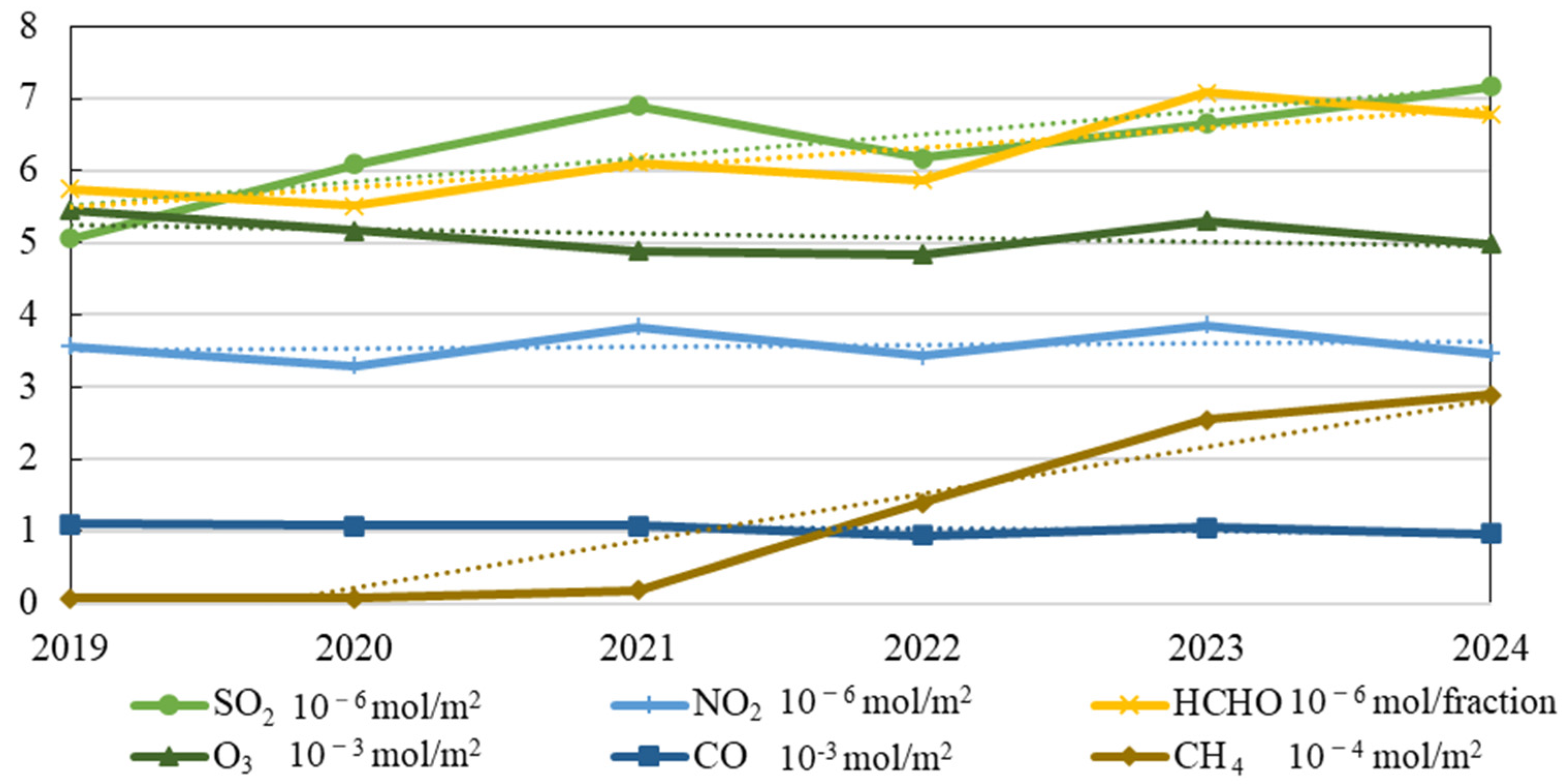




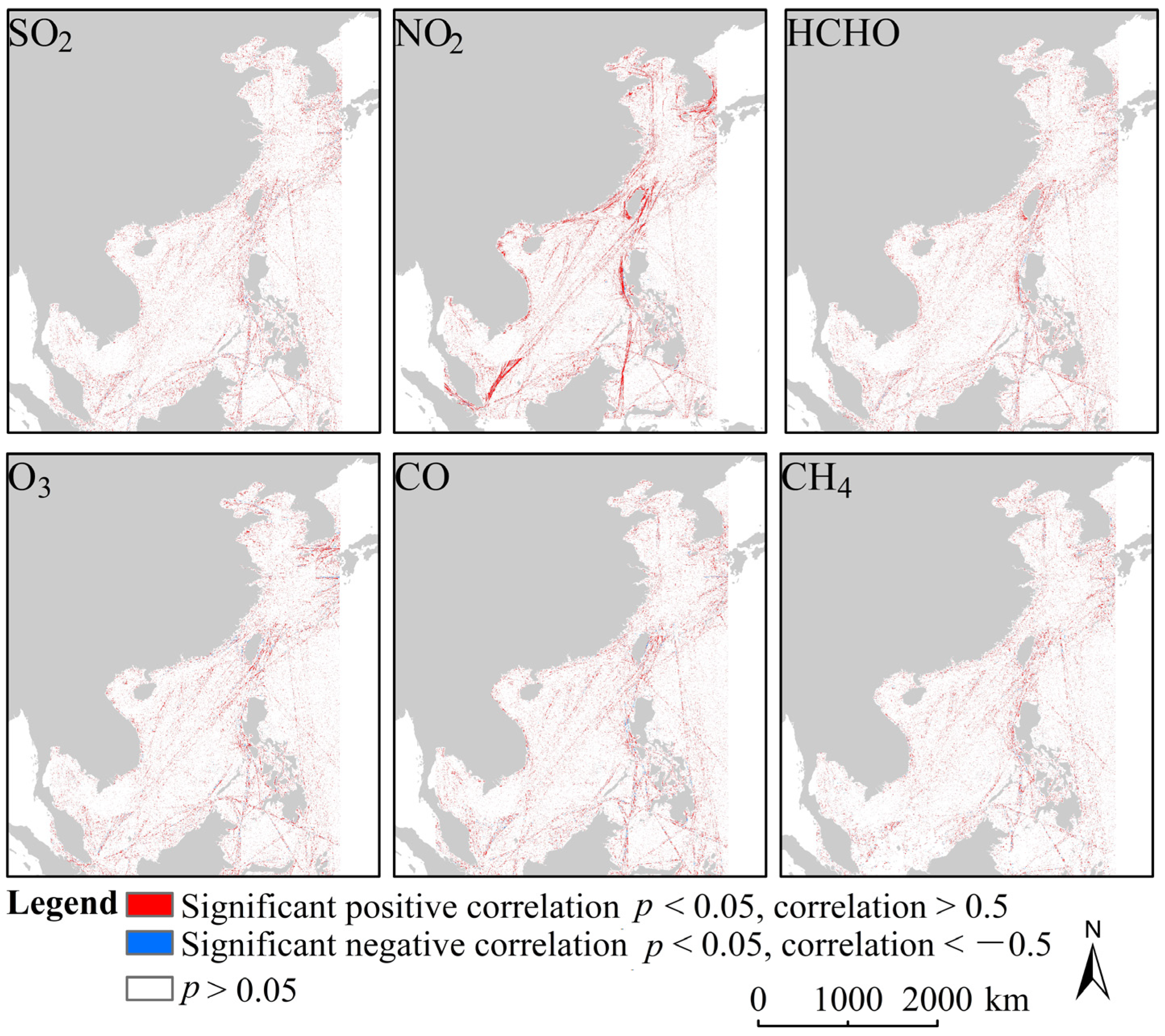
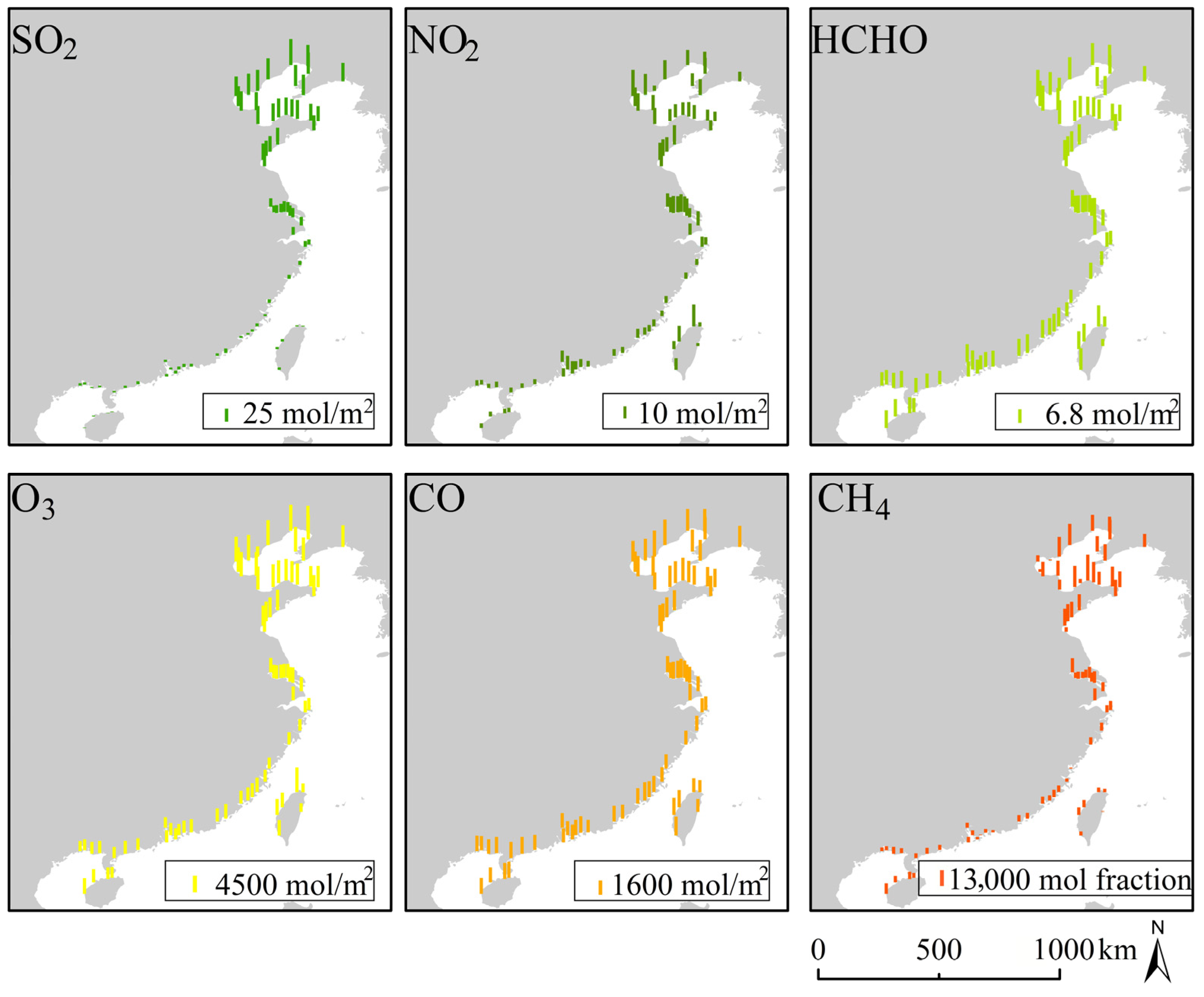
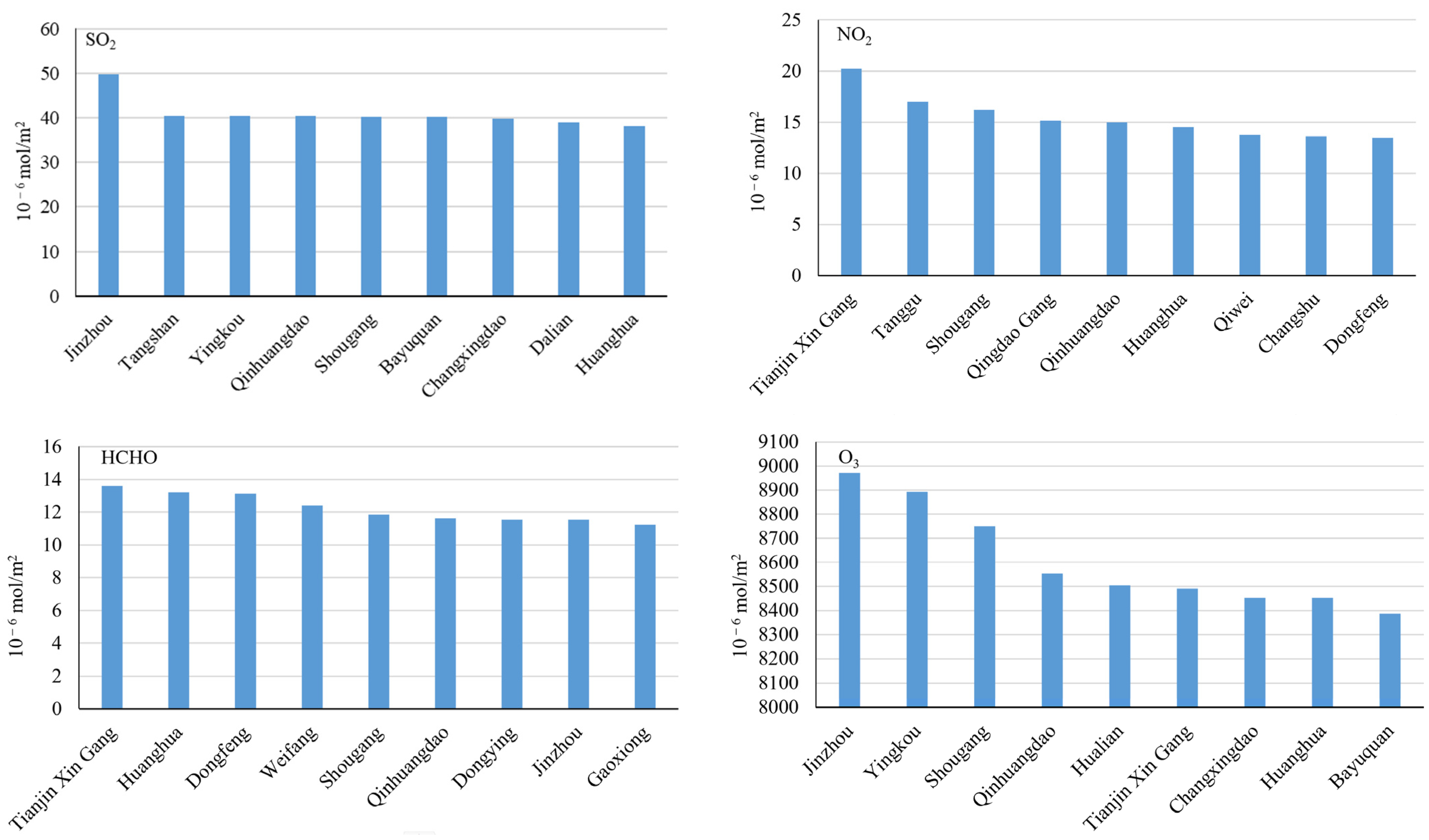

| Trend Parameter Conditions | Trend Category |
|---|---|
| slope > 0, 2.58 < Z | Extremely significant increase |
| slope > 0, 1.96 < Z ≤ 2.58 | Significant increase |
| slope > 0, Z ≤ 1.96 | No significant increase |
| slope = 0 | No change |
| slope < 0, 2.58 < Z | Very significant decrease |
| slope < 0, 1.96 < Z ≤ 2.58 | Significant decrease |
| slope < 0, Z ≤ 1.96 | No significant decrease |
Disclaimer/Publisher’s Note: The statements, opinions and data contained in all publications are solely those of the individual author(s) and contributor(s) and not of MDPI and/or the editor(s). MDPI and/or the editor(s) disclaim responsibility for any injury to people or property resulting from any ideas, methods, instructions or products referred to in the content. |
© 2025 by the authors. Licensee MDPI, Basel, Switzerland. This article is an open access article distributed under the terms and conditions of the Creative Commons Attribution (CC BY) license (https://creativecommons.org/licenses/by/4.0/).
Share and Cite
Yan, X.; Wang, J.; Wu, F.; Bai, J.; Zhang, X.; Li, G.; Fei, H. Spatial and Temporal Variation Characteristics of Air Pollutants in Coastal Areas of China: From Satellite Perspective. Remote Sens. 2025, 17, 1861. https://doi.org/10.3390/rs17111861
Yan X, Wang J, Wu F, Bai J, Zhang X, Li G, Fei H. Spatial and Temporal Variation Characteristics of Air Pollutants in Coastal Areas of China: From Satellite Perspective. Remote Sensing. 2025; 17(11):1861. https://doi.org/10.3390/rs17111861
Chicago/Turabian StyleYan, Xinrong, Juanle Wang, Fang Wu, Jing Bai, Xun Zhang, Guiping Li, and Haibo Fei. 2025. "Spatial and Temporal Variation Characteristics of Air Pollutants in Coastal Areas of China: From Satellite Perspective" Remote Sensing 17, no. 11: 1861. https://doi.org/10.3390/rs17111861
APA StyleYan, X., Wang, J., Wu, F., Bai, J., Zhang, X., Li, G., & Fei, H. (2025). Spatial and Temporal Variation Characteristics of Air Pollutants in Coastal Areas of China: From Satellite Perspective. Remote Sensing, 17(11), 1861. https://doi.org/10.3390/rs17111861









